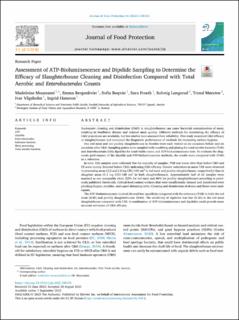| dc.contributor.author | Moazzami, Madeleine | |
| dc.contributor.author | Bergenkvist, Emma | |
| dc.contributor.author | Boqvist, Sofia | |
| dc.contributor.author | Frosth, Sara | |
| dc.contributor.author | Langsrud, Solveig | |
| dc.contributor.author | Møretrø, Trond | |
| dc.contributor.author | Vågsholm, Ivar | |
| dc.contributor.author | Hansson, Ingrid | |
| dc.date.accessioned | 2023-09-13T09:19:45Z | |
| dc.date.available | 2023-09-13T09:19:45Z | |
| dc.date.created | 2023-09-11T14:47:03Z | |
| dc.date.issued | 2023 | |
| dc.identifier.citation | Journal of Food Protection. 2023, 86 1-11. | |
| dc.identifier.issn | 0362-028X | |
| dc.identifier.uri | https://hdl.handle.net/11250/3089094 | |
| dc.description.abstract | Inadequate cleaning and disinfection (C&D) in slaughterhouses can cause bacterial contamination of meat, resulting in foodborne disease and reduced meat quality. Different methods for monitoring the efficacy of C&D procedures are available, but few studies have assessed their reliability. This study examined C&D efficacy in slaughterhouses and evaluated the diagnostic performance of methods for measuring surface hygiene. One red meat and one poultry slaughterhouse in Sweden were each visited on six occasions before and six occasions after C&D. Sampling points were sampled with: swabbing and plating for total aerobic bacteria (TAB) and Enterobacterales (EB); dipslides for total viable count; and ATP-bioluminescence tests. To evaluate the diagnostic performance of the dipslide and ATP-bioluminescence methods, the results were compared with (TAB) as a reference. In total, 626 samples were collected. For the majority of samples, TAB was lower after than before C&D and EB were mainly detected before C&D, indicating C&D efficacy. Greater reductions in mean TAB were observed in processing areas (2.2 and 2.8 log CFU/100 cm2 in red meat and poultry slaughterhouse, respectively) than in slaughter areas (1.3 log CFU/100 cm2 in both slaughterhouses). Approximately half of all samples were assessed as non acceptably clean (52% for red meat and 46% for poultry slaughterhouse) according to previously published thresholds. Critical food contact surfaces that were insufficiently cleaned and disinfected were plucking fingers, shackles, and a post-dehairing table. Cleaning and disinfection of drains and floors were inadequate. The ATP-bioluminescence method showed low specificity compared with the reference (TAB) in both the red meat (0.30) and poultry slaughterhouses (0.64). The sensitivity of dipslides was low (0.26) in the red meat slaughterhouse compared with TAB. A combination of ATP-bioluminescence and dipslides could provide more accurate estimates of C&D efficacy. | |
| dc.language.iso | eng | |
| dc.title | Assessment of ATP-Bioluminescence and Dipslide Sampling to Determine the Efficacy of Slaughterhouse Cleaning and Disinfection Compared with Total Aerobic and Enterobacterales Counts | |
| dc.title.alternative | Assessment of ATP-Bioluminescence and Dipslide Sampling to Determine the Efficacy of Slaughterhouse Cleaning and Disinfection Compared with Total Aerobic and Enterobacterales Counts | |
| dc.type | Peer reviewed | |
| dc.type | Journal article | |
| dc.description.version | publishedVersion | |
| dc.source.pagenumber | 1-11 | |
| dc.source.volume | 86 | |
| dc.source.journal | Journal of Food Protection | |
| dc.identifier.doi | https://doi.org/10.1016/j.jfp.2023.100155 | |
| dc.identifier.cristin | 2174064 | |
| dc.relation.project | Norges forskningsråd: 314743 | |
| dc.relation.project | Nofima AS: 202104 | |
| cristin.ispublished | true | |
| cristin.fulltext | original | |
| cristin.qualitycode | 1 | |
